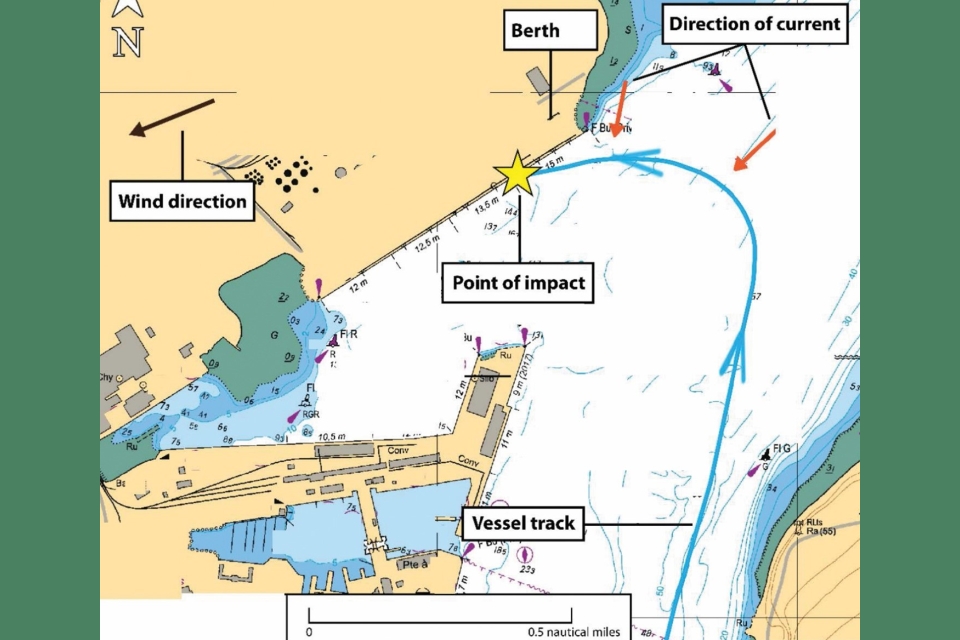In The Nautical Instute’s latest Mars Report, a bulk carrier hit its berth. In this case, the berthing plan did not account for wind and current conditions, which left little time for the crew to take effective corrective action.
The Nautical Institute gathers reports of maritime accidents and near-misses. It then publishes these so-called Mars Reports (anonymously) to prevent other accidents from happening. A summary of this incident:
A bulk carrier was approaching its assigned berth under pilotage. The master and a helmsman were on the bridge.
The pilot explained his berthing plan to the master and the master informed the pilot of the vessel’s manoeuvring particularities, among other things that the vessel was equipped with a left-handed controllable-pitch propeller.
There was a flood current of between one and two knots, with very light winds in the same direction as the flood current. Given these conditions, and that it was daylight with good visibility, it was decided that no tugs were needed for the berthing.
The pilot was monitoring his Portable Pilot Unit (PPU) and providing helm orders to the helmsman and propulsion orders to the master. From his position, the master was able to see the ECDIS display. As the vessel approached the berth, it was necessary to turn the vessel to port.
Also read: Fog and single-point failure lead to allision with bridge support
At one point, the pilot ordered hard to port and the bow thruster to full port. The pilot then asked the master to reduce speed. The vessel completed half of its turning circle toward the berth. Its speed at that time was 2.2 knots.
Shortly after, the pilot noticed visually and on the PPU that the vessel’s approach trajectory had changed; the predicted trajectory was no longer parallel to the berth as planned, but would result in contact with the berth. The vessel’s rate of turn had noticeably slowed, and the vessel’s speed had increased to 2.7 knots.
The vessel continued to turn slowly to port as it approached the berth, now at a speed of 3.2 knots. The vessel was now positioned in such a way that the forward part of the vessel was lined up with the berth, while the aft part of the vessel extended past the berth. The vessel continued to advance toward the berth at a speed of about three knots, but had stopped turning to port. Collision with the berth was now unavoidable, and the pilot ordered the master to set the propeller pitch to full astern; however, the master had already done so shortly before hearing the order.
Shortly afterwards the vessel’s starboard bow hit the berth at a speed of 2.1 knots, striking between two pneumatic floating rubber fenders at an angle of approximately 30°. One of the berth’s D-shaped rubber fenders punctured the vessel’s starboard bow. After the impact, the pilot asked the master to complete the docking.
Also read: Tug order mix-up leads to allision and shore crane collapse
Investigation findings
The official investigation found, among other things, that:
- The flood current acted against the port turning moment, reducing the vessel’s rate of turn. Consequently, the vessel was not parallel to the berth as it made its final approach.
- As a result of the incomplete turn to port and the combined effect of the current and wind, the vessel approached the berth at a speed of about 3 knots, limiting the time available for the crew to take effective corrective action to prevent the vessel from striking the berth.
Also read: LPG carrier hits berthed tug and dock in following current
Advice from The Nautical Institute
- Bridge team members must consistently communicate to establish a shared understanding of a vessel’s status, to ensure that crucial manoeuvres for safe navigation are adequately planned, coordinated, and executed.
- If a passage plan does not include a realistic berth approach that integrates actual conditions and vessel characteristics, there is a risk that bridge team members will not establish a shared mental model and therefore be unable to effectively monitor and anticipate the vessel’s progress during the berthing manoeuvre.
- Even when wind and current conditions are seemingly benign, berthing a large bulk carrier without tugs is a tricky affair, especially turning across a current and then having it astern.
Mars Reports
This accident was covered in the Mars Reports, originally published as Mars 202325, that are part of Report Number 367. A selection of this Mars Report was also published in SWZ|Maritime’s June 2023 issue. The Nautical Institute compiles these reports to help prevent maritime accidents. That is why they are also published (in full) on SWZ|Maritime’s website.
More reports are needed to keep the scheme interesting and informative. All reports are read only by the Mars coordinator and are treated in the strictest confidence. To submit a report, please use the Mars report form.
Also read: Bridge resource management gone wrong: VLCC hits buoy and almost collides with anchored ship








